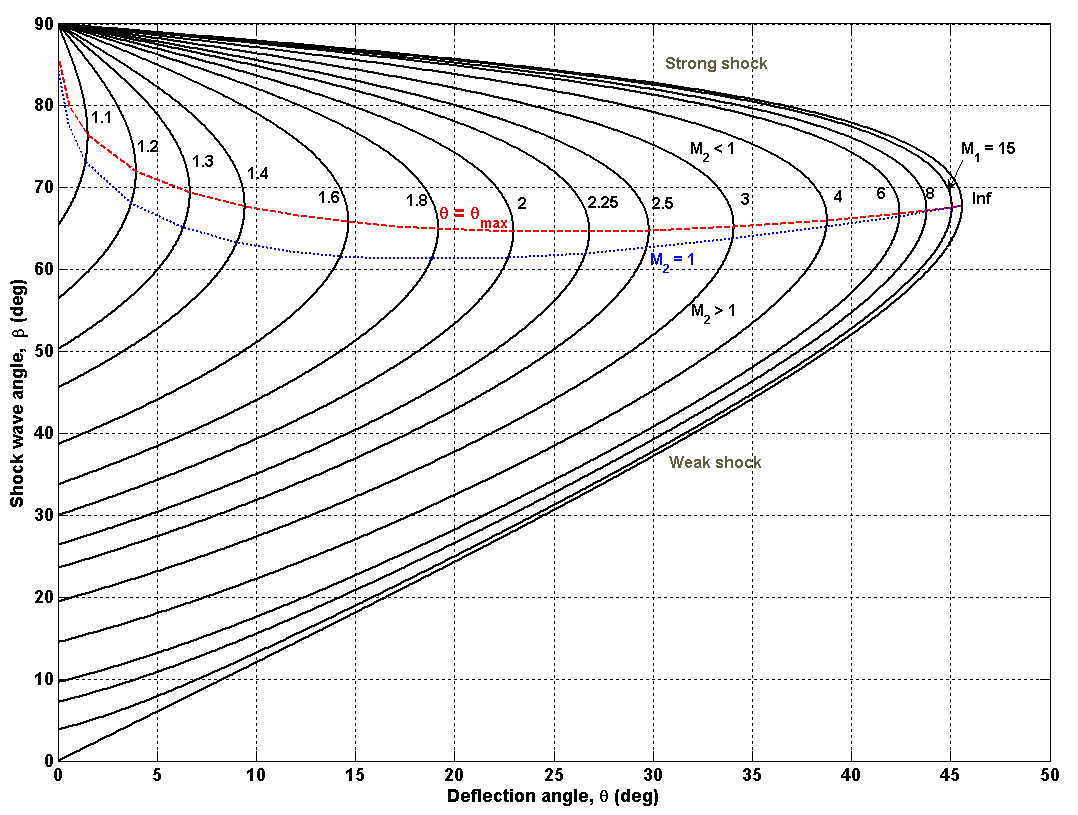oblique shock wave on:
[Wikipedia]
[Google]
[Amazon]
An oblique shock wave is a

 For a given
For a given

 Oblique shocks are often preferable in engineering applications when compared to normal shocks. This can be attributed to the fact that using one or a combination of oblique shock waves results in more favourable post-shock conditions (smaller increase in entropy, less stagnation pressure loss, etc.) when compared to utilizing a single normal shock. An example of this technique can be seen in the design of supersonic aircraft engine intakes or supersonic inlets. A type of these inlets is wedge-shaped to compress air flow into the combustion chamber while minimizing thermodynamic losses. Early supersonic aircraft jet engine intakes were designed using compression from a single normal shock, but this approach caps the maximum achievable Mach number to roughly 1.6.
Oblique shocks are often preferable in engineering applications when compared to normal shocks. This can be attributed to the fact that using one or a combination of oblique shock waves results in more favourable post-shock conditions (smaller increase in entropy, less stagnation pressure loss, etc.) when compared to utilizing a single normal shock. An example of this technique can be seen in the design of supersonic aircraft engine intakes or supersonic inlets. A type of these inlets is wedge-shaped to compress air flow into the combustion chamber while minimizing thermodynamic losses. Early supersonic aircraft jet engine intakes were designed using compression from a single normal shock, but this approach caps the maximum achievable Mach number to roughly 1.6.
NASA oblique shock wave calculator
{{Webarchive, url=https://web.archive.org/web/20110718150939/http://www.grc.nasa.gov/WWW/K-12/airplane/oblique.html , date=2011-07-18 (
Supersonic wind tunnel test demonstration (Mach 2.5) with flat plate and wedge creating an oblique shock(Video)
Aerodynamics Fluid dynamics Shock waves
shock wave
In physics, a shock wave (also spelled shockwave), or shock, is a type of propagating disturbance that moves faster than the local speed of sound in the medium. Like an ordinary wave, a shock wave carries energy and can propagate through a me ...
that, unlike a normal shock, is inclined with respect to the incident upstream flow direction. It will occur when a supersonic flow encounters a corner that effectively turns the flow into itself and compresses. The upstream streamlines are uniformly deflected after the shock wave. The most common way to produce an oblique shock wave is to place a wedge into supersonic
Supersonic speed is the speed of an object that exceeds the speed of sound ( Mach 1). For objects traveling in dry air of a temperature of 20 °C (68 °F) at sea level, this speed is approximately . Speeds greater than five times ...
, compressible flow
Compressible flow (or gas dynamics) is the branch of fluid mechanics that deals with flows having significant changes in fluid density. While all flows are compressible, flows are usually treated as being incompressible when the Mach number (the r ...
. Similar to a normal shock wave, the oblique shock wave consists of a very thin region across which nearly discontinuous changes in the thermodynamic properties of a gas occur. While the upstream and downstream flow directions are unchanged across a normal shock, they are different for flow across an oblique shock wave.
It is always possible to convert an oblique shock into a normal shock by a Galilean transformation
In physics, a Galilean transformation is used to transform between the coordinates of two reference frames which differ only by constant relative motion within the constructs of Newtonian physics. These transformations together with spatial rotat ...
.
Wave theory
 For a given
For a given Mach number
Mach number (M or Ma) (; ) is a dimensionless quantity in fluid dynamics representing the ratio of flow velocity past a boundary to the local speed of sound.
It is named after the Moravian physicist and philosopher Ernst Mach.
: \mathrm = \f ...
, M1, and corner angle, θ, the oblique shock angle, β, and the downstream Mach number, M2, can be calculated. Unlike after a normal shock where M2 must always be less than 1, in oblique shock M2 can be supersonic (weak shock wave) or subsonic (strong shock wave). Weak solutions are often observed in flow geometries open to atmosphere (such as on the outside of a flight vehicle). Strong solutions may be observed in confined geometries (such as inside a nozzle intake). Strong solutions are required when the flow needs to match the downstream high pressure condition. Discontinuous changes also occur in the pressure, density and temperature, which all rise downstream of the oblique shock wave.
The θ-β-M equation
Using thecontinuity equation
A continuity equation or transport equation is an equation that describes the transport of some quantity. It is particularly simple and powerful when applied to a conserved quantity, but it can be generalized to apply to any extensive quantity. ...
and the fact that the tangential velocity component does not change across the shock, trigonometric relations eventually lead to the θ-β-M equation which shows θ as a function of M1 β, and ɣ, where ɣ is the Heat capacity ratio
In thermal physics and thermodynamics, the heat capacity ratio, also known as the adiabatic index, the ratio of specific heats, or Laplace's coefficient, is the ratio of the heat capacity at constant pressure () to heat capacity at constant vol ...
.
It is more intuitive to want to solve for β as a function of M1 and θ, but this approach is more complicated, the results of which are often contained in tables or calculated through a numerical method
In numerical analysis, a numerical method is a mathematical tool designed to solve numerical problems. The implementation of a numerical method with an appropriate convergence check in a programming language is called a numerical algorithm.
Mathem ...
.
Maximum deflection angle
Within the θ-β-M equation, a maximum corner angle, θMAX, exists for any upstream Mach number. When θ > θMAX, the oblique shock wave is no longer attached to the corner and is replaced by a detachedbow shock
In astrophysics, a bow shock occurs when the magnetosphere of an astrophysical object interacts with the nearby flowing ambient plasma such as the solar wind. For Earth and other magnetized planets, it is the boundary at which the speed of th ...
. A θ-β-M diagram, common in most compressible flow textbooks, shows a series of curves that will indicate θMAX for each Mach number. The θ-β-M relationship will produce two β angles for a given θ and M1, with the larger angle called a strong shock and the smaller called a weak shock. The weak shock is almost always seen experimentally.
The rise in pressure, density, and temperature after an oblique shock can be calculated as follows:
M2 is solved for as follows:
Wave applications

Concorde
The Aérospatiale/BAC Concorde () is a retired Franco-British supersonic airliner jointly developed and manufactured by Sud Aviation (later Aérospatiale) and the British Aircraft Corporation (BAC).
Studies started in 1954, and France an ...
(which first flew in 1969) used variable geometry wedge-shaped intakes to achieve a maximum speed of Mach 2.2. A similar design was used on the F-14 Tomcat
The Grumman F-14 Tomcat is an American carrier-capable supersonic aircraft, supersonic, twinjet, twin-engine, two-seat, twin-tail, variable-sweep wing fighter aircraft. The Tomcat was developed for the United States Navy's Naval Fighter Experi ...
(the F-14D was first delivered in 1994) and achieved a maximum speed of Mach 2.34.
Many supersonic aircraft wings are designed around a thin diamond shape. Placing a diamond-shaped object at an angle of attack relative to the supersonic flow streamlines will result in two oblique shocks propagating from the front tip over the top and bottom of the wing, with Prandtl-Meyer expansion fans created at the two corners of the diamond closest to the front tip. When correctly designed, this generates lift.
Waves and the hypersonic limit
As the Mach number of the upstream flow becomes increasingly hypersonic, the equations for the pressure, density, and temperature after the oblique shock wave reach a mathematicallimit
Limit or Limits may refer to:
Arts and media
* ''Limit'' (manga), a manga by Keiko Suenobu
* ''Limit'' (film), a South Korean film
* Limit (music), a way to characterize harmony
* "Limit" (song), a 2016 single by Luna Sea
* "Limits", a 2019 ...
. The pressure and density ratios can then be expressed as:
For a perfect atmospheric gas approximation using γ = 1.4, the hypersonic limit for the density ratio is 6. However, hypersonic post-shock dissociation of O2 and N2 into O and N lowers γ, allowing for higher density ratios in nature. The hypersonic temperature ratio is:
See also
* Bow shock (aerodynamics) *Gas dynamics
Compressible flow (or gas dynamics) is the branch of fluid mechanics that deals with flows having significant changes in fluid density. While all flows are compressible, flows are usually treated as being incompressible when the Mach number (the ...
* Mach reflection
Mach reflection is a supersonic fluid dynamics effect, named for Ernst Mach, and is a shock wave reflection pattern involving three shocks.
Introduction
Mach reflection can exist in steady, pseudo-steady and unsteady flows. When a shock wave, ...
* Moving shock
* Shock polar The term ''shock polar'' is generally used with the graphical representation of the Rankine–Hugoniot equations in either the hodograph plane or the pressure ratio-flow deflection angle plane. The polar itself is the locus of all possible states a ...
* Shock wave
In physics, a shock wave (also spelled shockwave), or shock, is a type of propagating disturbance that moves faster than the local speed of sound in the medium. Like an ordinary wave, a shock wave carries energy and can propagate through a me ...
References
* * *External links
NASA oblique shock wave calculator
{{Webarchive, url=https://web.archive.org/web/20110718150939/http://www.grc.nasa.gov/WWW/K-12/airplane/oblique.html , date=2011-07-18 (
Java applet
Java applets were small applications written in the Java programming language, or another programming language that compiles to Java bytecode, and delivered to users in the form of Java bytecode. The user launched the Java applet from a ...
)
Supersonic wind tunnel test demonstration (Mach 2.5) with flat plate and wedge creating an oblique shock(Video)
Aerodynamics Fluid dynamics Shock waves